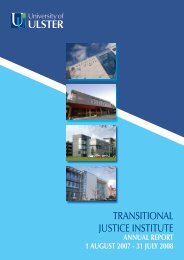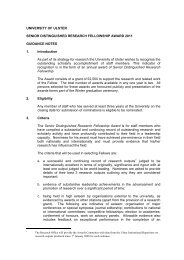biomedical sciences research institute - Research - University of Ulster
biomedical sciences research institute - Research - University of Ulster
biomedical sciences research institute - Research - University of Ulster
- No tags were found...
You also want an ePaper? Increase the reach of your titles
YUMPU automatically turns print PDFs into web optimized ePapers that Google loves.
Dr Mateus Webba da SilvaLecturer in Pharmaceutical ChemistryContact Details:T: +44 (0)28 70324009mm.webba-da-silva@ulster.ac.ukMost <strong>of</strong> cellular DNA exists as a double-helix composed <strong>of</strong> A:T and G:C base pairings.However, nucleic acids can also adopt other architectures. In particular, G-rich sequencescan fold into four-stranded structures denominated G-quadruplexes. Dr Silva’s generalinterests reside in the application <strong>of</strong> nucleic acids structural & chemical biology to<strong>biomedical</strong> problems. Current areas <strong>of</strong> interest include (i) understanding the role <strong>of</strong>G-quadruplex folds in regulation <strong>of</strong> gene expression; and (ii) design <strong>of</strong> nucleic acidarchitectures for <strong>biomedical</strong> and biotechnological applications.Recently, evidence has emerged suggesting that quadruplex architectures regulate geneexpression. Dr Silva and his team have identified putative quadruplex folding regions in aseries <strong>of</strong> human genes with crucial regulatory functions, investigated the propensity forquadruplex folding utilizing and developing biochemical, biophysical and molecular biology methods, and identifiedligands that selectively target some <strong>of</strong> these architectures. In these studies they have developed the means to modulatethe productivity <strong>of</strong> select genes that affect human conditions and disease states. In particular they established theinnate propensity <strong>of</strong> G-quadruplex folding <strong>of</strong> a region containing transcription factor binding sites within the proximalpromoter <strong>of</strong> fibroblast growth factor 2 (FGF2 also known as bFGF). This gene encodes a protein with roles in broadangiogenic, mitogenic, and neurotrophic activities. It is the most extensively studied growth factor and is involvedin numerous cellular functions in various cell types, including angiogenesis, cell proliferation, cell differentiation,tumorigenesis, tissue remodeling, wound healing, and limb formation. They developed methodology to directly assessformation <strong>of</strong> a specific topology/structure within the context <strong>of</strong> the double helical region, established the propensity<strong>of</strong> a DNA segment <strong>of</strong> a gene to fold into a G-quadruplex. They have thus demonstrated how propensity <strong>of</strong> a primarysequence to form an identified quadruplex topology perturbs the equilibrium between the closed double helix andopen single strands. Studies on modulation <strong>of</strong> gene expression continue on systems in vivo.Dr Silva’s team has also identified a set <strong>of</strong> ligands that induce and/or stabilize the folding <strong>of</strong> a G-quadruplex in theproximal promoter <strong>of</strong> OTX2. The orthodenticle homeobox 2 gene (OTX2) encodes a member <strong>of</strong> the bicoid subfamily<strong>of</strong> homeodomain-containing transcription factors. Recently it has been established that OTX2 overexpressioncan trigger a critical period <strong>of</strong> neuronal plasticity. Modulating regulation <strong>of</strong> OTX2 expression is believed to playa role in enhancing mental agility in old age, help treat neurological disorders as diverse as Alzheimer’s, stroke,schizophrenia, and autism. These studies continue towards the development <strong>of</strong> drugs that can up-regulate or downregulateOTX2 expression.Dr Silva’s team is developing fundamental rules for prediction, design and control self-assembly <strong>of</strong> DNA G-quadruplextopologies. They have translated some <strong>of</strong> these rules into computational algorithms that have been used to design abinitio a series <strong>of</strong> small quadruplex topologies (15-35 nucleotides) with exciting properties: they are extremely resistantto DNAse 1 and S1-nuclease, do not denature in the presence <strong>of</strong> known denaturants, and do not disassemble evenin boiling aqueous considitions! They are currently being investigated towards some <strong>biomedical</strong> and biotechnologicalapplications.Publications:Webba da Silva M; Geometric formalism for DNA quadruplex folding; Chem. Eur. J., 13: 9738-9745, 2007Webba da Silva M; NMR methods for studying quadruplex nucleic acids; Methods, 43: 264-277, 200718
















